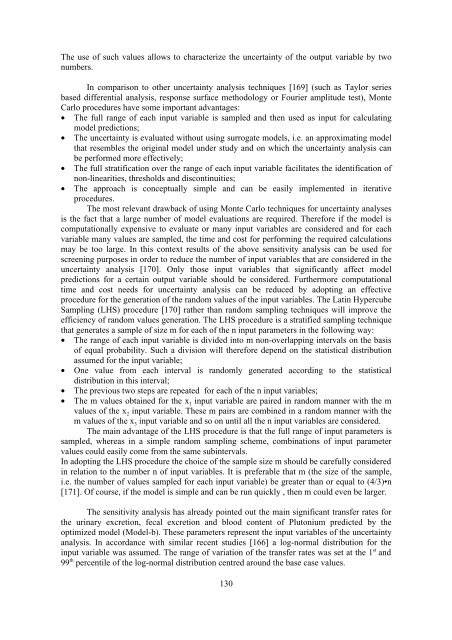Plutonium Biokinetics in Human Body A. Luciani - Kit-Bibliothek - FZK
Plutonium Biokinetics in Human Body A. Luciani - Kit-Bibliothek - FZK
Plutonium Biokinetics in Human Body A. Luciani - Kit-Bibliothek - FZK
Create successful ePaper yourself
Turn your PDF publications into a flip-book with our unique Google optimized e-Paper software.
The use of such values allows to characterize the uncerta<strong>in</strong>ty of the output variable by two<br />
numbers.<br />
In comparison to other uncerta<strong>in</strong>ty analysis techniques [169] (such as Taylor series<br />
based differential analysis, response surface methodology or Fourier amplitude test), Monte<br />
Carlo procedures have some important advantages:<br />
• The full range of each <strong>in</strong>put variable is sampled and then used as <strong>in</strong>put for calculat<strong>in</strong>g<br />
model predictions;<br />
• The uncerta<strong>in</strong>ty is evaluated without us<strong>in</strong>g surrogate models, i.e. an approximat<strong>in</strong>g model<br />
that resembles the orig<strong>in</strong>al model under study and on which the uncerta<strong>in</strong>ty analysis can<br />
be performed more effectively;<br />
• The full stratification over the range of each <strong>in</strong>put variable facilitates the identification of<br />
non-l<strong>in</strong>earities, thresholds and discont<strong>in</strong>uities;<br />
• The approach is conceptually simple and can be easily implemented <strong>in</strong> iterative<br />
procedures.<br />
The most relevant drawback of us<strong>in</strong>g Monte Carlo techniques for uncerta<strong>in</strong>ty analyses<br />
is the fact that a large number of model evaluations are required. Therefore if the model is<br />
computationally expensive to evaluate or many <strong>in</strong>put variables are considered and for each<br />
variable many values are sampled, the time and cost for perform<strong>in</strong>g the required calculations<br />
may be too large. In this context results of the above sensitivity analysis can be used for<br />
screen<strong>in</strong>g purposes <strong>in</strong> order to reduce the number of <strong>in</strong>put variables that are considered <strong>in</strong> the<br />
uncerta<strong>in</strong>ty analysis [170]. Only those <strong>in</strong>put variables that significantly affect model<br />
predictions for a certa<strong>in</strong> output variable should be considered. Furthermore computational<br />
time and cost needs for uncerta<strong>in</strong>ty analysis can be reduced by adopt<strong>in</strong>g an effective<br />
procedure for the generation of the random values of the <strong>in</strong>put variables. The Lat<strong>in</strong> Hypercube<br />
Sampl<strong>in</strong>g (LHS) procedure [170] rather than random sampl<strong>in</strong>g techniques will improve the<br />
efficiency of random values generation. The LHS procedure is a stratified sampl<strong>in</strong>g technique<br />
that generates a sample of size m for each of the n <strong>in</strong>put parameters <strong>in</strong> the follow<strong>in</strong>g way:<br />
• The range of each <strong>in</strong>put variable is divided <strong>in</strong>to m non-overlapp<strong>in</strong>g <strong>in</strong>tervals on the basis<br />
of equal probability. Such a division will therefore depend on the statistical distribution<br />
assumed for the <strong>in</strong>put variable;<br />
• One value from each <strong>in</strong>terval is randomly generated accord<strong>in</strong>g to the statistical<br />
distribution <strong>in</strong> this <strong>in</strong>terval;<br />
• The previous two steps are repeated for each of the n <strong>in</strong>put variables;<br />
• The m values obta<strong>in</strong>ed for the x 1 <strong>in</strong>put variable are paired <strong>in</strong> random manner with the m<br />
values of the x 2 <strong>in</strong>put variable. These m pairs are comb<strong>in</strong>ed <strong>in</strong> a random manner with the<br />
m values of the x 3 <strong>in</strong>put variable and so on until all the n <strong>in</strong>put variables are considered.<br />
The ma<strong>in</strong> advantage of the LHS procedure is that the full range of <strong>in</strong>put parameters is<br />
sampled, whereas <strong>in</strong> a simple random sampl<strong>in</strong>g scheme, comb<strong>in</strong>ations of <strong>in</strong>put parameter<br />
values could easily come from the same sub<strong>in</strong>tervals.<br />
In adopt<strong>in</strong>g the LHS procedure the choice of the sample size m should be carefully considered<br />
<strong>in</strong> relation to the number n of <strong>in</strong>put variables. It is preferable that m (the size of the sample,<br />
i.e. the number of values sampled for each <strong>in</strong>put variable) be greater than or equal to (4/3)•n<br />
[171]. Of course, if the model is simple and can be run quickly , then m could even be larger.<br />
The sensitivity analysis has already po<strong>in</strong>ted out the ma<strong>in</strong> significant transfer rates for<br />
the ur<strong>in</strong>ary excretion, fecal excretion and blood content of <strong>Plutonium</strong> predicted by the<br />
optimized model (Model-b). These parameters represent the <strong>in</strong>put variables of the uncerta<strong>in</strong>ty<br />
analysis. In accordance with similar recent studies [166] a log-normal distribution for the<br />
<strong>in</strong>put variable was assumed. The range of variation of the transfer rates was set at the 1 st and<br />
99 th percentile of the log-normal distribution centred around the base case values.<br />
130












![{A1[]Sp - Bibliothek](https://img.yumpu.com/21908054/1/184x260/a1sp-bibliothek.jpg?quality=85)




